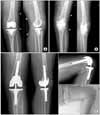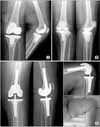Abstract
Purpose
The treatment results of a two-stage reimplantation of infected total knee arthroplasty with either the articulating or non-articulating types of antibiotic-loaded bone cement spacers were compared and analyzed.
Materials and Methods
Between July 1995 and October 2005, this study reviewed 29 patients who underwent two-stage reimplantation of infected total knee arthroplasty and were followed up for at least 2 years. Of the 29 cases, 12 used articulating and 17 used the non-articulating type.
Results
Fifteen cases (52%) showed bacterial growth in the preoperative and intraoperative bacterial culture, and 14 cases (48%) had no growth. 27 cases showed no evidence of reinfection until the last follow up after two-stage reimplantation. One out of the 12 cases in the articulating group and 1 out of the 17 cases in the non-articulating group had a reinfection. The range of motion (ROM) of the knee joint and HSS knee rating scale increased more significantly in the articulating group than in the non-articulating group, and the degree of increase in the ROM of the knee joint and HSS knee rating scale was significantly larger in the articulating group.
Figures and Tables
Fig. 1
This 65 year-old woman visited our clinic with infection of left total knee arthroplasty that was done in other hospital 39 months ago (A). We performed the first stage reimplantation with non-articulating cement spacer and beads (B). Infection was controlled 8 weeks after the first stage reimplantation, then we performed the second stage reimplantation (C). At last follow up (52 months after reimplantation), ROM of left knee joint was 110° and HSS rating scale was 75 points, which were 78° and 47 points preoperatively.

Fig. 2
This 68 year-old woman visited our clinic with infection of left total knee arthroplasty that was done in other hospital 4 months ago (A). We performed the first stage reimplantation with articulating cement spacer (B). Infection was controlled 6 weeks after the first stage reimplantation, then we performed the second stage reimplantation (C). At last follow up (38 months after reimplantation), ROM of left knee joint was 103° and HSS rating scale was 89 points, which were 60° and 44 points preoperatively.

Fig. 3
In articulating group, non-antibiotics loaded cement was applied on the surface of femoral component of implant or trial and separated after it has gone hard, hence a mold was made. Antibiotic oint was applied on the inner surface of the mold to avoid the antibiotic loaded cement sticking to the mold. Antibiotic loaded cement was applied to the exposed femur in dough phase and the mold was attached to it. Then, the attachment of the two parts was pressed until the cement fuse on each parts. After the fusion of cement, the mold was removed using osteotome.

References
1. Cui Q, Mihalko WM, Shields JS, Ries M, Saleh KJ. Antibiotic-impregneted cement spacers for the treatment of infection associated with total hip or knee arthroplasty. J Bone Joint Surg Am. 2007. 89:871–882.
2. Meek RM, Masri BA, Dunlop D, et al. Patient satisfaction and functional status after treatment of infection at the site of a total knee arthroplasty with use of the PROSTALAC articulating spacer. J Bone Joint Surg Am. 2003. 85:1888–1892.

3. Mittal Y, Fehring TK, Hanssen A, Marculescu C, Odum SM, Osmon D. Two-stage reimplantation for periprosthetic knee infection involving resistant organisms. J Bone Joint Surg Am. 2007. 89:1227–1231.

4. Tsukayama DT, Goldberg VM, Kyle R. Diagnosis and management of infection after total knee arthroplasty. J Bone Joint Surg Am. 2003. 85:suppl 1. 75–80.

5. Bannister GC, Johnson DP. The outcome of infected arthroplasty of the knee. J Bone Joint Surg Br. 1986. 68:289–291.
6. Goldman RT, Scuderi GR, Insall JN. 2-stage reimplantation for infected total knee replacement. Clin Orthop Relat Res. 1996. (331):118–124.

7. Whiteside LA. Treatment of infected total knee arthroplasty. Clin Orthop Relat Res. 1994. (299):169–172.

8. Emerson RH Jr, Muncie M, Tarbox TR, Higgins LL. Comparison of a static with a mobile spacer in total knee infection. Clin Orthop Relat Res. 2002. (404):132–138.

9. Fehring TK, Odum S, Calton TF, Mason JB. Articulating versus static spacers in revision total knee arthroplasty for sepsis. The Ranawat Award. Clin Orthop Relat Res. 2000. (380):9–16.
10. Haddad FS, Masri BA, Campbell D, McGraw RW, Beauchamp CP, Duncan CP. The PROSTALAC functional spacer in two-stage revision for infected knee replacements. Prosthesis of antibiotic-loaded acrylic cement. J Bone Joint Surg Br. 2000. 82:807–812.
11. Hart WJ, Jones RS. Two-stage revision of infected total knee replacements using articulating cement spacers and short-term antibiotic therapy. J Bone Joint Surg Am. 2006. 88:1011–1015.

12. Masri BA, Kendall RW, Duncan CP, Beauchamp CP, McGraw RW, Bora B. Two-stage exchange arthroplasty using a functional antibiotic-loaded spacer in the treatment of the infected knee replacement: the Vancouver experience. Semin Arthroplasty. 1994. 5:122–136.
13. Pitto RP, Spica IA. Antibiotic-loaded bone cement spacers in two-stage management of infected total knee arthroplasty. Int Orthop. 2004. 28:129–133.

14. Hoffmann AA, Kane KR, Tkach TK, Plaster RL, Camargo MP. Treatment of infected total knee arthroplasty using an articulating spacer. Clin Orthop Relat Res. 1995. (321):45–54.
15. Bae DK, Yim CM, Yang HS. Treatment of infection after total knee arthroplasty. J Korean Orthop Assoc. 1999. 34:501–508.

16. Bose WJ, Gearen PF, Randall JC, Petty W. Long-term outcome of 42 knees with chronic infection after total knee arthroplasty. Clin Orthop Relat Res. 1995. (319):285–296.

17. Hannsen AD, Rand JA, Osmon DR. Treatment of the infected total knee arthroplasty with insertion of another prosthesis. The effect of antibiotic-impregnated bone cement. Clin Orthop Relat Res. 1994. (309):44–55.
18. Rand JA, Bryan RS. Reimplantation for the salvage of an infected total knee arthroplasty. J Bone Joint Surg Am. 1983. 65:1081–1086.

19. Insall JN, Thompson FM, Brause BD. Two-stage reimplantation for the salvage of infected total knee arthroplasty. J Bone Joint Surg Am. 1983. 65:1087–1098.

20. Durbhakula SM, Czajka J, Fuchs MD, Uhl RL. Antibiotic-loaded articulating cement spacer in the 2-stage exchange of infected total knee arthroplasty. J Arthroplasty. 2004. 19:768–774.

21. Evans RP. Successful treatment of total hip and knee infection with articulating antibiotic components: a modified treatment method. Clin Orthop Relat Res. 2004. (427):37–46.




 PDF
PDF ePub
ePub Citation
Citation Print
Print





 XML Download
XML Download